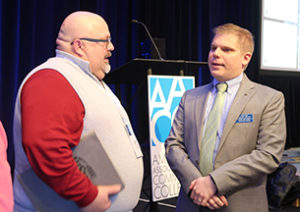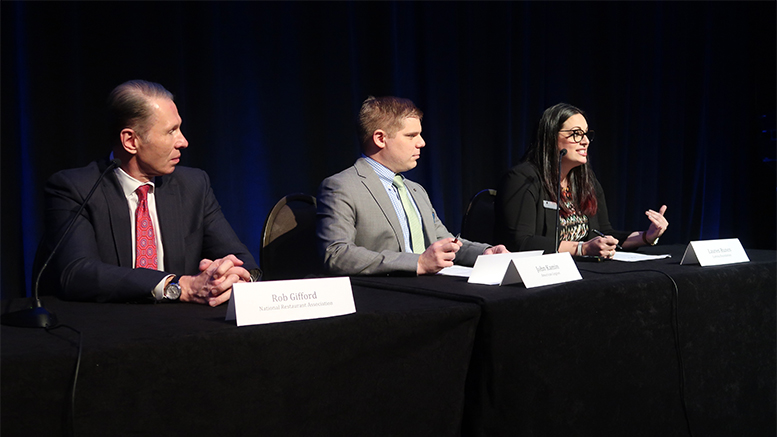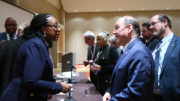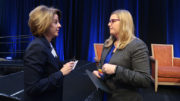AMELIA ISLAND, Fla. — Community colleges are playing a major role in helping military members transition to private-sector careers, but more is needed to better align the skills people learn in the military with employers’ requirements.
That’s the conclusion of experts who spoke Wednesday at the opening session of the American Association of Community Colleges’ Workforce Development Institute.
Ensuring that military training counts toward a higher education credential is critical if Lumina Foundation will be able to meet its goal of having 60 percent of Americans attain a high-quality postsecondary credential by 2025, said Lauren Runco, Lumina’s strategy officer for military-based learning.
That means moving away from the type of institution-focused learning of yesterday in which postsecondary learning can only happen at traditional higher education institutions, Runco said.
Instead, today’s learning must be “learner-centered,” she said. “We have to move from a system of exclusion to one of inclusion,” and that calls for evaluating and rewarding what someone knows and can do, regardless of where they were trained. That’s the basis of Lumina’s All Learning Counts initiative.
If people can’t transfer what they learned in the military to postsecondary education, “we’re leaving them behind,” Runco said. “Lumina is prioritizing servicemembers and veterans,” she said, as that group is vital to meeting the 2025 goal.
Runco noted it takes servicemembers seven to 10 years to complete an associate degree, while the median time people spend in the military is five years.
“The onus is on us to marry what they’re doing in the military with what they’re doing in the community,” she said.
Validated prior learning
The Department of Defense and service branches are starting to recognize what servicemembers know and can do and award them a credential before they leave the service, but that’s not the norm, Runco said. Too often, “veterans are forced to retrain, requalify or start over.”
Prior learning assessments are one way for higher education institutions to evaluate someone’s knowledge and skills not previously validated, Runco said. But that calls for the applicant to take a test or put together a portfolio. Sometimes a person is awarded credit for prior learning, but it’s usually not applied to a degree program.
“Validated learning” is better, she said. In this system, prior learning is recognized and valued without the need for a reassessment. It’s even more effective if people can get that certification before leaving the military.
Lumina is conducting a Military Credentialing Advancement study that supports pilot projects to build pathways from the military to higher education and to careers and replicate them at scale.
Filling the skills gap
Jobs that previously required a high school diploma now require a four-year degree, Kamin noted.

Scott Lucas, vice president of career and technical education at Wichita State University Campus of Applied Sciences and Technology, and the American Legion’s John Kamin.
Community colleges can play a critical role in aligning military experience – particularly in such areas a food service management, warehouse management and personnel administration – with degree requirements, said John Kamin, assistant director of veterans employment and education at the American Legion.
Training in the military has a different focus, so community colleges need to fill the gaps, Kamin noted. For example, food service training in the military doesn’t cover customer service, and military cooks are taught to make everything bland.
It’s important that community colleges take a lead role in reaching out to veterans, Kamin said. Otherwise, veterans will turn to for-profit colleges. That has led to disastrous results, as many of those institutions have shut down, leaving veterans with no credits and lots of debt.
Kamin urged community colleges to create a welcoming, military-friendly atmosphere by establishing a veterans center and student club for veterans.
An early start
Rob Gifford, president of the National Restaurant Association Educational Foundation, called for a new way of thinking about the transition from the military. Instead of viewing it as three separate phases – military service, the transition and an industry career – it should be seen as a continuum.
While people are still in the military, their training should be done with the goal of transitioning to an industry career without the need for starting over, Gifford said.
Most people only think about what’s next when they’re a few months from leaving the service, he said. Instead, there should be a clear pathway all along. “Industry has a huge obligation” to accept military training as a qualification for a job, he said.
The restaurant industry has begun working with the military to see how training in the service can match with the competencies and standards the industry wants in a restaurant manager.
The National Restaurant Association has embraced apprenticeships for veterans and is working with the Department of Defense’s Skillbridge program, which allows people to work with a mentor in the private sector during their last six weeks in the military.
Employers also need to be educated about the skills people get in the military and the transition experience, Gifford said.
“As an industry group we can be doing a better job of getting the military to understand how skills gained in the service can be translated into civilian careers,” he said.



